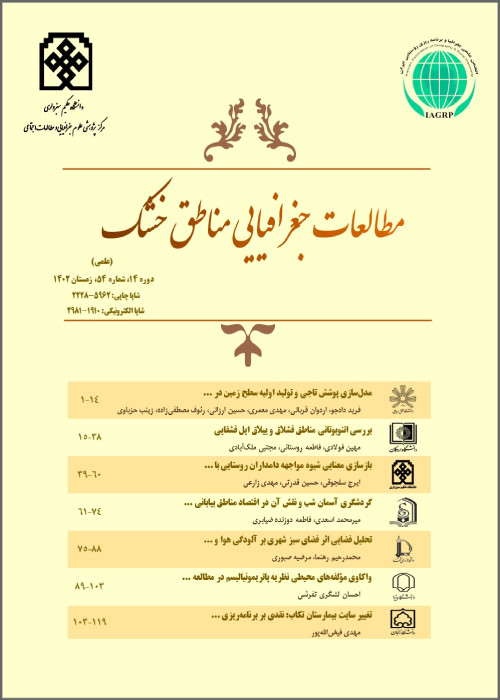Assessment of Risk and Hazard desertification using Topsis-GIS method (Case Study: Bashtin, Sabzevar, Razavi province)
Among the global issues, climate change, desertification, and water shortage are the three major crises in the 21st century. Desertification is challenged universally and its consequences are threatening human life and natural ecosystems. Desertification, the process of land degradation in arid and semi-arid lands, is one of the most complicated problems that can occur globally, regionally and nationally scales. Some of the effective factors on desertification include climate change, overgrazing, over-drafting of groundwater, deforestation, over-exploitation of natural lands which varies from region to region. According to reports, approximately 80% of Iran is located in the arid and semi-arid area and approximately 35 % of this area is prone to desertification. On the other side, to achieve sustainable development, the evaluation of desertification risk and its vulnerability is needed to be used as an effective tool for assessing qualitative and quantitative aspects of desert lands. This will help planners identify the critical points to guide them toward the low-risk areas and also to prevent the waste of facilities and limited resources. For this purpose, it is necessary to recognize the desertification indicators to provide a model for assessment of the desertification severity and its risk. This study was aimed to investigate the desertification hazard and its risk in Bashtin, Sabzevar by the Topsis-GIS method.
Material and Method
For modeling, the spatial distribution of desertification risk in Bashtin, Sabzevar, the TOPSIS, and GIS models were used. The Technique for Order of Preference by Similarity to Ideal Solution (TOPSIS) is a multi-criteria decision analysis method, which was originally developed by Hwang and Yoon in 1981 with further developments by Yoon in 1987, and Hwang, Lai and Liu in 1993. The TOPSIS concept is based on the shortest geometric distance from the positive ideal solution (PIS) and the longest geometric distance from the negative ideal solution (NIS). In this study, the principal indices of desertification were determined, and the effective indicators in Bashtin, Sabzevar were chosen among the different indices identified for the desertification phenomenon. To complete the desertification hazard assessment, the IMDPA model parameters were given to the experts' group consisting of nine experts and six parameters (geology, dryness, annual precipitation, soil salinity, soil texture and the percentage of vegetation) were selected, using Delphi and AHP methods. Also, the elements at risk and their vulnerability were prepared, and finally the risk map was established upon them. To assess the risk of desertification, each indicator was classified and standardized based on the IMPDA model using ArcGIS software. The indices were weighted by the use of the Analytical Hierarchy Process (AHP). To integrate the standardized maps and calculate desertification risk, the TOPSIS techniques and GIS operators were used. The desertification risk in the study area was achieved using the following equation: R=H×E×V, where: H: is the desertification hazard, E: the elements at risk and V: the vulnerability map at each pixel in the raster that is formed.
The results showed that the soil and water salinity were the most effective factors in the desertification of Bashtin. Most of the region classified into the hazard class II (35/54%) and the minimum of the area is located in class I (8/05%). Critical classes of desertification hazard (IV and V) cover 50% of the area. These areas are mostly located near Kal-e Shour and in the southern agricultural lands of the city. Also, Most of the region (56/68%) is classified into the risk class II. The statistical analysis shows a statistically significant difference (at a level of 99%) between the spatial distribution of risk and hazard classes in the Bashtin region.
Based on the desertification risk map, it can be concluded that most of the area is located in the moderate class of desertification risk. According to the findings, the villages, roads, and wells are at higher risk of desertification. Upon the obtained results, the western part of Sabzevar city along the Sabzevar-Tehran road was classified into a severe risk of desertification. This is due to the high vulnerability of risk elements with severe hazard class that has increased in the risk class which led to the critical condition of desertification. In this regard, the desertification risk map can be used to prioritize the Bashtin area to de-desertification programs.
- حق عضویت دریافتی صرف حمایت از نشریات عضو و نگهداری، تکمیل و توسعه مگیران میشود.
- پرداخت حق اشتراک و دانلود مقالات اجازه بازنشر آن در سایر رسانههای چاپی و دیجیتال را به کاربر نمیدهد.


